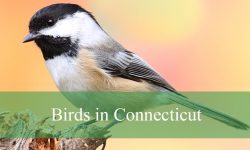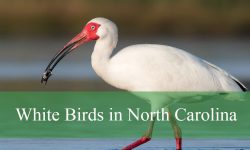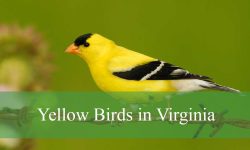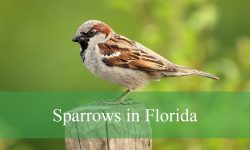There is a great diversity of bee species found in North America, each with special traits and functions within the ecosystem. Examining the many types of bees provides an enlightening look into the world of pollinators, from the well-known honeybee to the lesser-known solitary bees.
The article below will help you explore the 72 types of bees that can be found in North America, learn about their characteristics, and learn how to identify them.
Different Types of Bees
American Bumble Bee
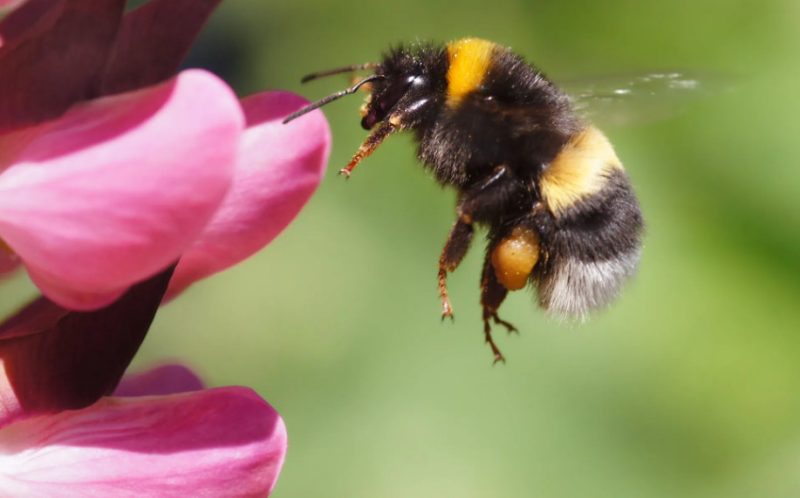
The Eastern and Southeastern US are home to the American Bumble Bee (Bombus pensylvanicus), which lives in colonies with a clear hierarchy headed by a big queen. Smaller female workers develop to a maximum of 19mm, while queens can reach up to 26mm. The female population of the colony grows as a result of fertilized eggs put in the nest.
Two-Spotted Bumble Bee
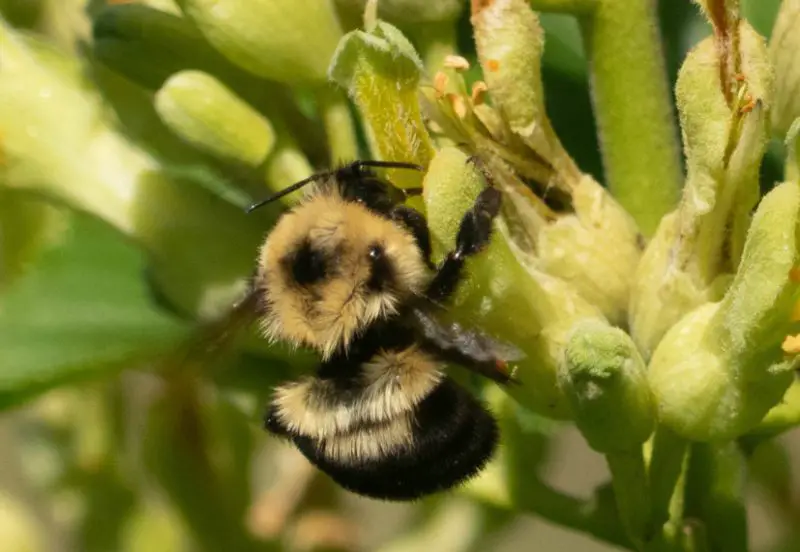
One of the most common species of bumble bee in North America is the Two-spotted Bumble Bee (Bombus bimaculatus), which is identified by its black body and yellow spots. Unlike other bumble bees, they make their nests in shallow ground burrows. Nectar and pollen from a variety of flowers and plants, including zenobia lilies and willows, are part of their diet.
Ligated Furrow Bee
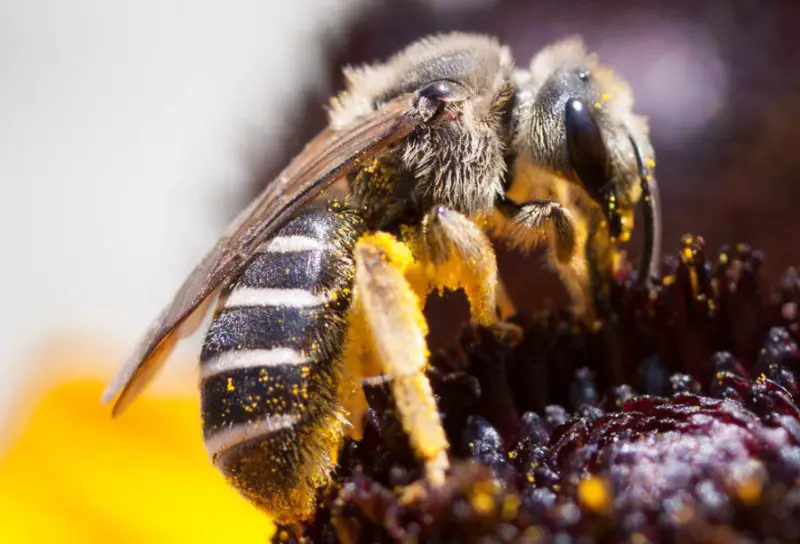
An important pollinator is the native North American Halictus ligatus, or Ligated Furrow Bee. It prefers clear soil for its re-used nests and builds its nests on bare soils or decaying wood. Workers gather pollen to feed the young, and queens manage the colony. High levels of violence are displayed by this species, mostly as a means of establishing control within the colony.
Yellow-Faced Bumble Bee
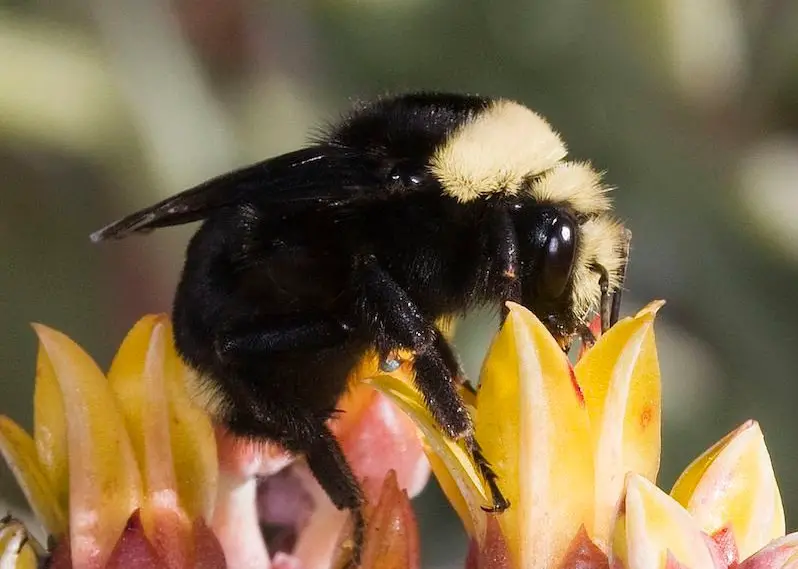
The Yellow-Faced Black bodies with yellow patterns on their cheeks and thoraxes are the defining feature of bumble bees (Bombus vosnesenskii). They nest in the earth and are mostly found on the US West Coast. Well-known as important pollinators, particularly in greenhouses, they have a taste for certain plants such as tomatoes, lantana, and asters, but are less common in cities than in rural areas.
Pure Gold-Green Sweat Bee
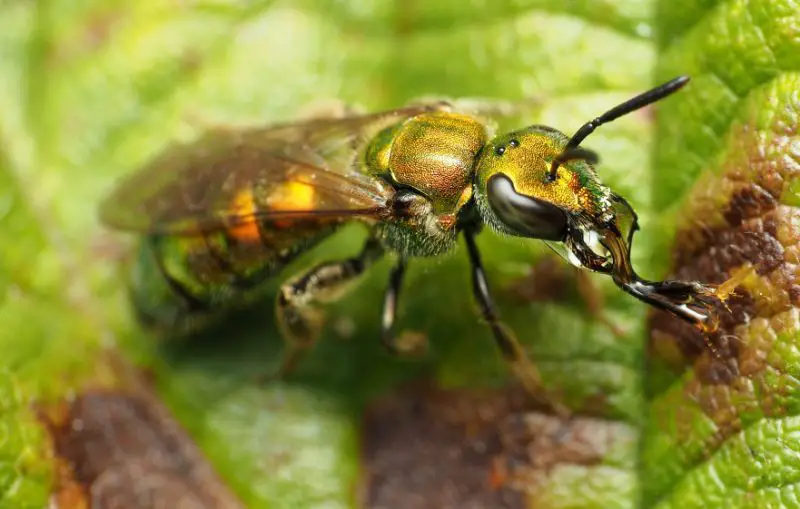
The metallic green Pure Gold-Green Sweat Bee (Augochlora pura) is a common species in the woodlands of the Eastern United States. Both sexes live alone without a colony structure, building their nests in trees or on the ground. Even though they are loners, they get very aggressive when they come across occupied nests. As pollinators, these bees are essential to woods and surrounding environments.
Bicolored Striped Sweat Bee
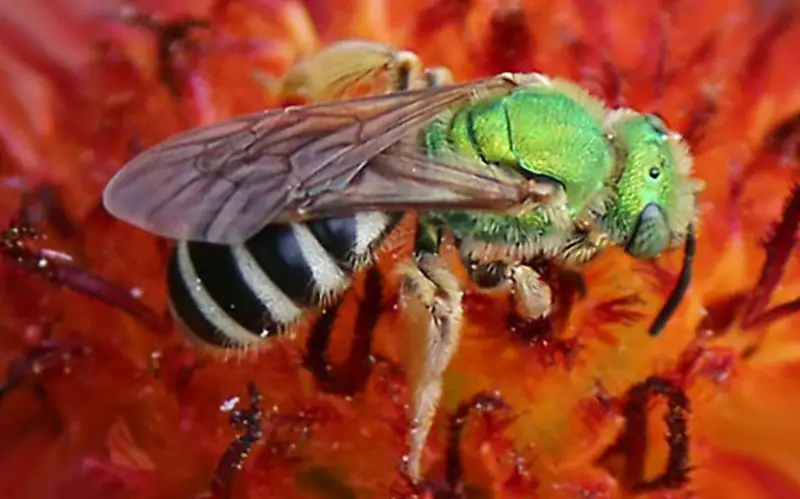
Although some females may be completely green, the Bicolored Striped Sweat Bee (Agapostemon virescens) is easily identified by its characteristic green thorax and black-and-white striped abdomen. Usually solitary, females build their own nests, but sometimes they share. These nests are used as both overwintering and summer shelters. They are avid visitors of nectar-rich flowers like asters, sunflowers, and goldenrods.
Two-Spotted Longhorn Bee
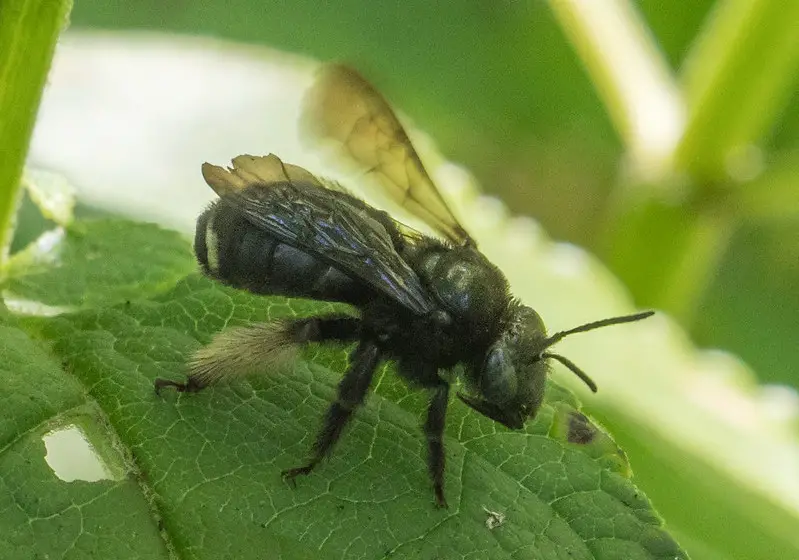
Native to North America, the Two-Spotted Longhorn Bee (Melissodes bimaculatus) is identified by its mostly black body. It is active in the spring and summer, preferring dry land environments close to woodlands or crops, and is well-known for its role in pollinating asters and crops. To feed the young members of their species, these bees gather pollen.
Black-Tailed Bumble Bee
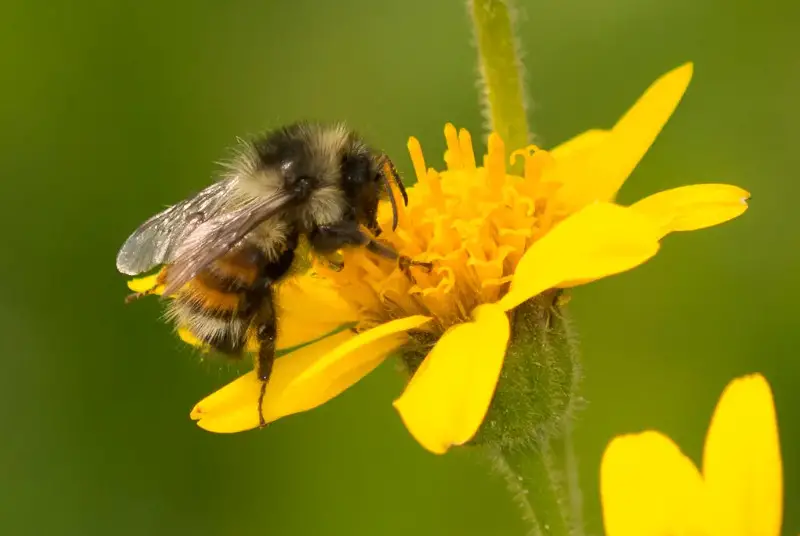
In Western North America, the Black-Tailed Bumble Bee (Bombus melanopygus) is common, especially in California and Oregon, and it has been observed as far north as Alaska. It is primarily black in color and can take on several morphologies. It is one of the most prevalent species of bumble bee in California and is essential to the pollination of native plants like willows and sage as well as crops.
Valley Carpenter Bee
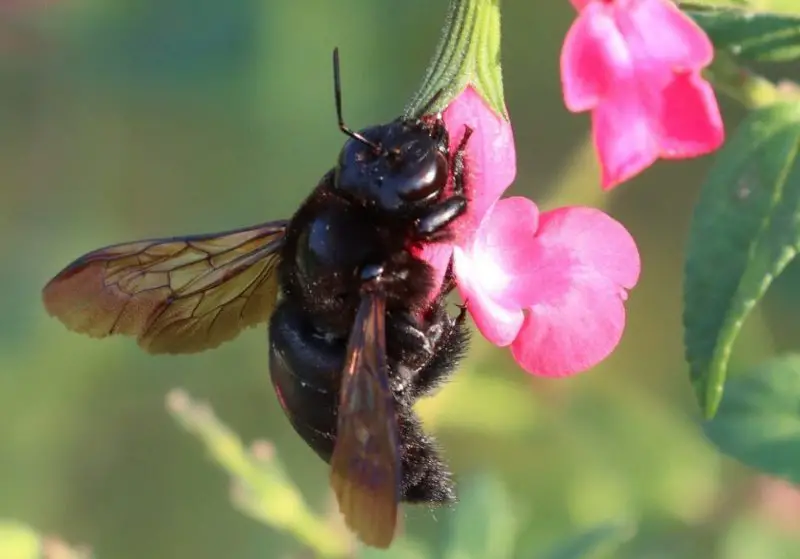
Native to the Southern and Southwestern US, including Texas, Arizona, California, and Hawaii, is the Valley Carpenter Bee (Xylocopa sonorina). Male bees are golden-brown in color and have no stings, while females have all-black bodies and smokey brown wings. Even though they are frequently seen, they usually stay away from people, and the females only sting when provoked.
Tricolored Bumble Bee
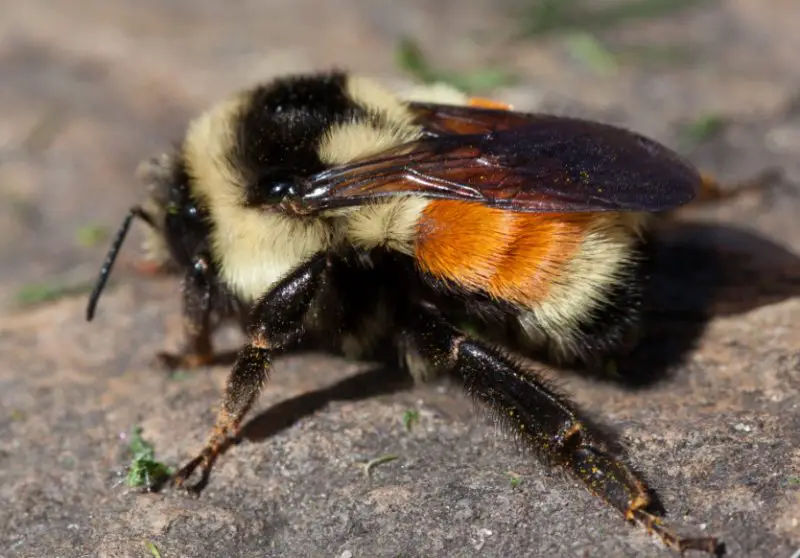
The three primary colors of Tricolored Bumble Bees (Bombus ternarius) are orange, white, and black, which gives rise to its name. They are found throughout Canada and several Northern US states, where their bodies are covered in hair. Although workers can grow up to 13 mm in length, the bigger queen—who can reach 19 mm—is essential to the colony’s defense and reproductive success because she has a stinger.
European Woolcarder Bee
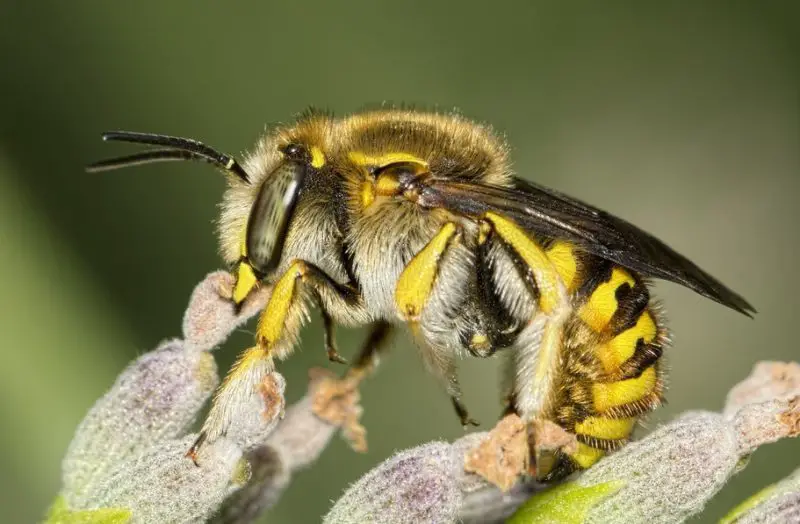
Originally from Europe, the European Woolcarder Bee (Anthidium manicatum) has been brought to North America and other areas. Its largely black body with yellow edges on the abdomen and thorax helps to identify it. It is a generalist feeder that feeds on a variety of plants, including garden types. These bees line and polish their nests using plant fibers and dirt.
Horse-Fly Carpenter
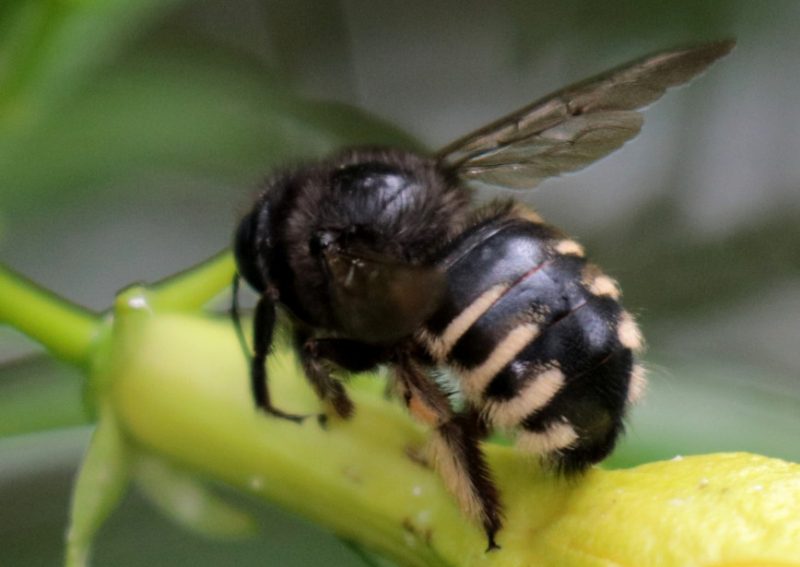
North and South American Horse-fly Carpenters (Xylocopa tabaniformis) are sexually dimorphic, with females being black and males having black with yellow patterns. They are most common in Southern Texas and Northern California, although they are also found in Mexico. Their summertime diet of pollen from various plants and weeds keeps their numbers alive.
Black-And-Gold Bumble Bee
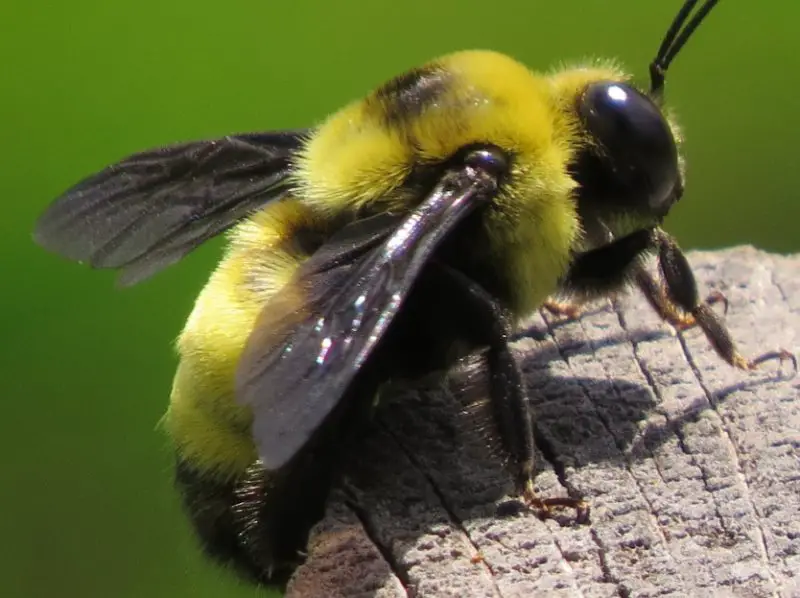
Primarily found in the Southern United States, the Black-and-Gold Bumble Bee (Bombus auricomus) resides in colonies headed by a queen. Although workers and queens are both black and yellow in hue, queens are greater in stature. There are two yellow spots on the head and several yellow bands on the abdomen of males, often known as drones. They live in meadows with a variety of crops, including fields of clover.
Golden Northern Bumble Bee
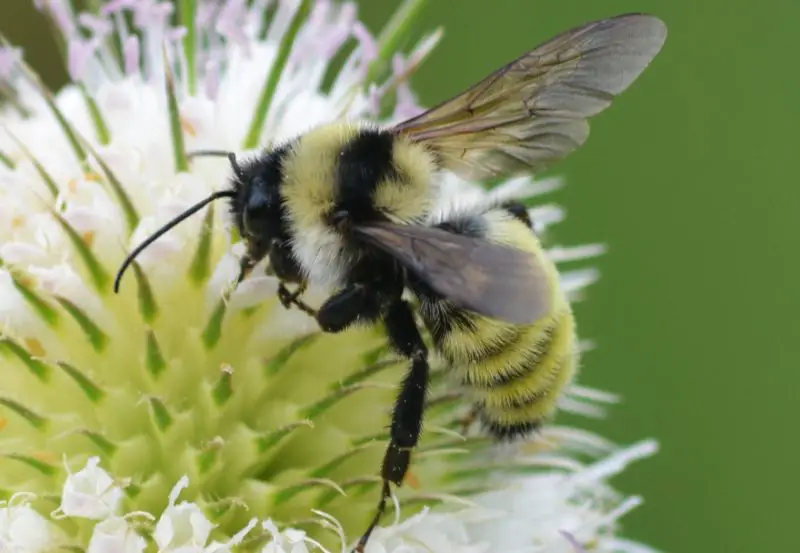
The thorax and body of the Golden Northern Bumble Bee (Bombus fervidus) are distinguished by alternating bands of black and yellow. They are mostly found in the Northeastern and Northwestern parts of the United States, and they are aggressive toward people. They live in nests where the queen and young are fed pollen while the adults drink nectar, and they perform a crucial role as pollinators in a variety of ecosystems, including crops, forests, and urban areas.
Southern Carpenter Bee
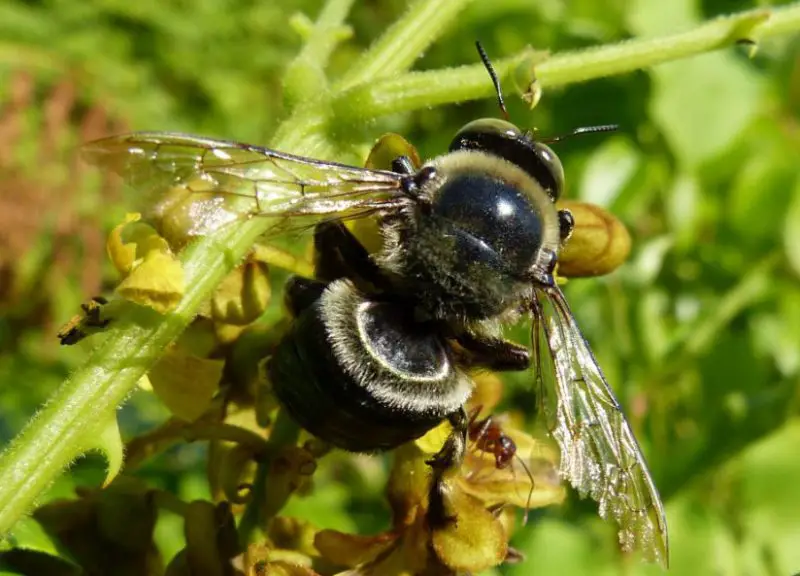
The all-black Southern Carpenter Bee (Xylocopa micans) is a native of the Southern United States, encompassing Florida, Texas, and Arizona. They are not regarded as pests by humans because they build their nests in woody materials without causing structural harm. As nectar and pollen feeders, they consume the mixture and then regurgitate it for their young, which is why they are called nectarvores.
Hunt’s Bumble Bee
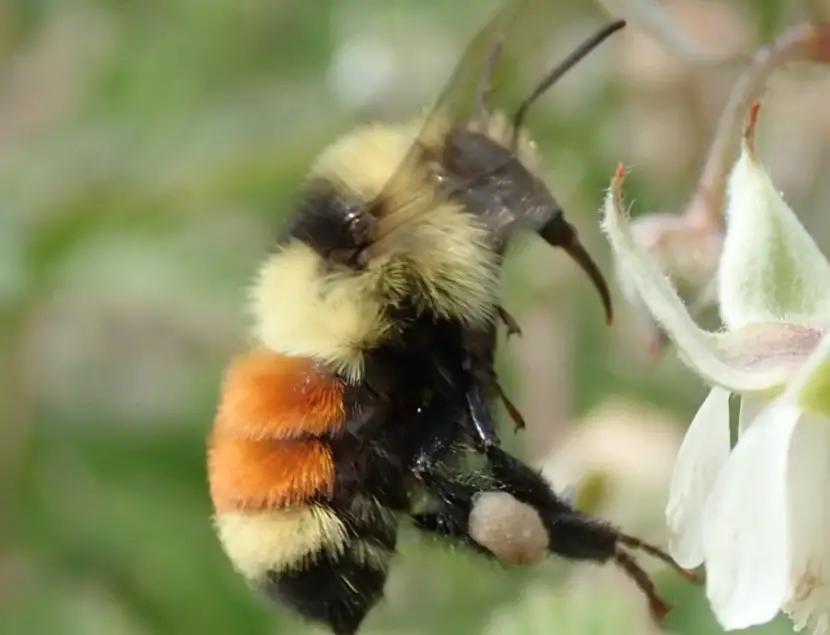
The black ventral coloring and the yellow and orange dorsal hues of the Hunt’s Bumble Bee (Bombus huntii) give it a distinctive tricolored look. Nesting underground, it is well-known for its helpful function in pollination, particularly for legumes. It has been cultivated in greenhouses and crops, yet it is native to areas abundant in sunflowers and thistles. It is often found in environments throughout the Southern United States and is active almost all year long.
Tripartite Sweat Bee
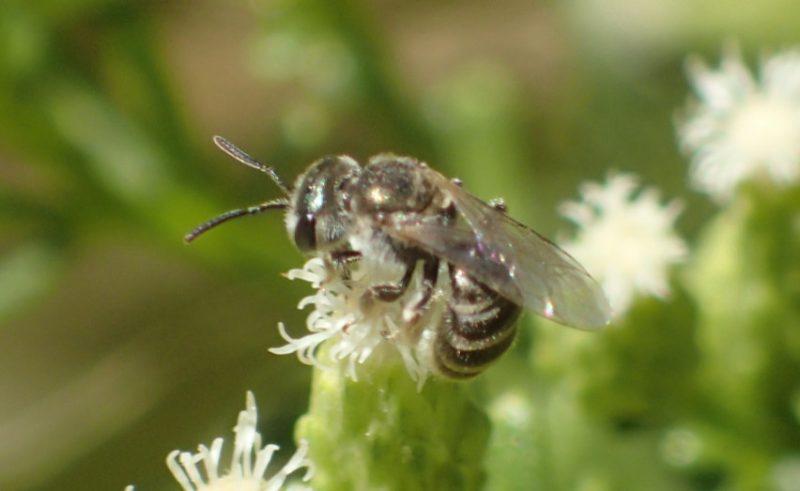
Native to North America, the Tripartite Sweat Bee (Halictus tripartitus) is colored in shades of brown, black, and yellow. Its habitat is located in the US and Canada to the west of the Rocky Mountains. It is a moderate pollinator that is active from spring to fall, visiting fields of sunflowers and gardens as well as different plant species such as milkweeds and sunflowers.
Western Honey Bee
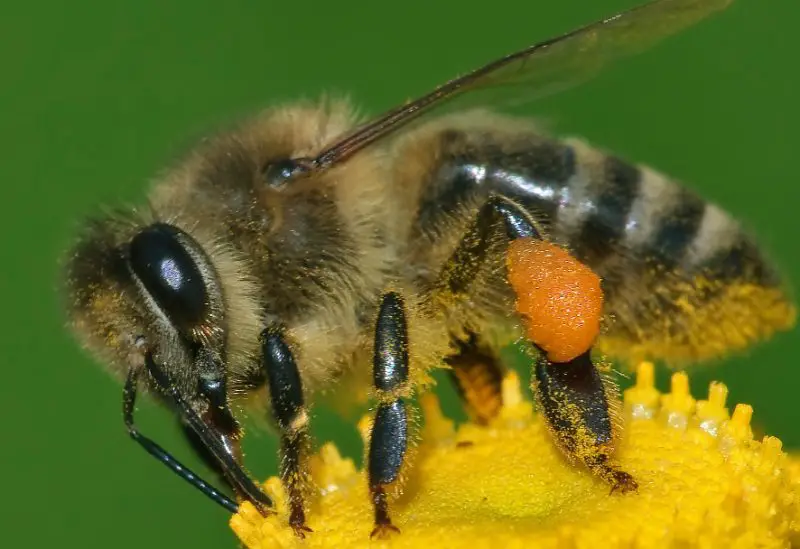
The most common species of honey bee worldwide, Western honey bees (Apis mellifera) are found on every continent. They establish enduring colonies, putting the survival of the colony ahead of the needs of the individual. Larger than other bees, colonies are ruled by a reproductive queen, and female workers keep them going, with male drones existing only to mate with the new queen.
Common Eastern Bumble Bee
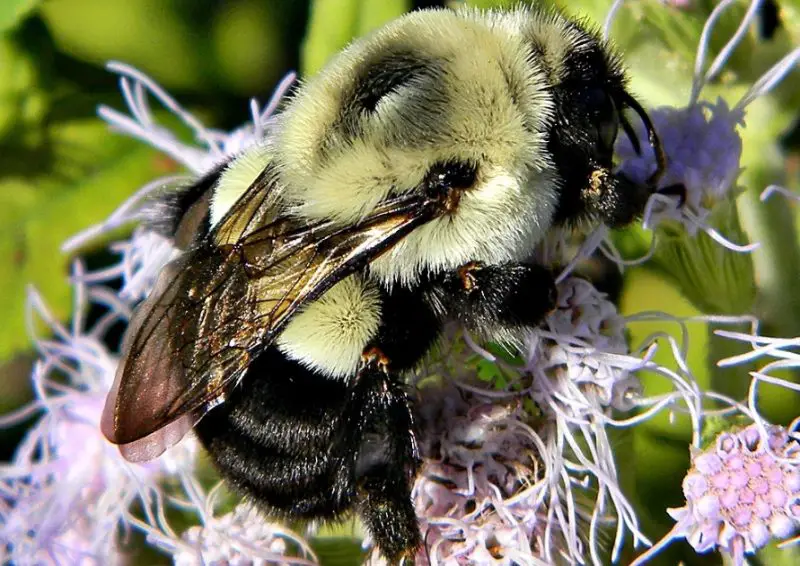
Throughout Eastern North America, the Common Eastern Bumble Bee (Bombus impatiens) is a common sight and an essential pollinator. They are nocturnal, underground nesters who depend on a caste of workers to keep their asymmetrical nests in good condition. These bees visit plants such as goldenrod and clover, where they gather nectar and pollen to sustain themselves.
Eastern Carpenter Bee
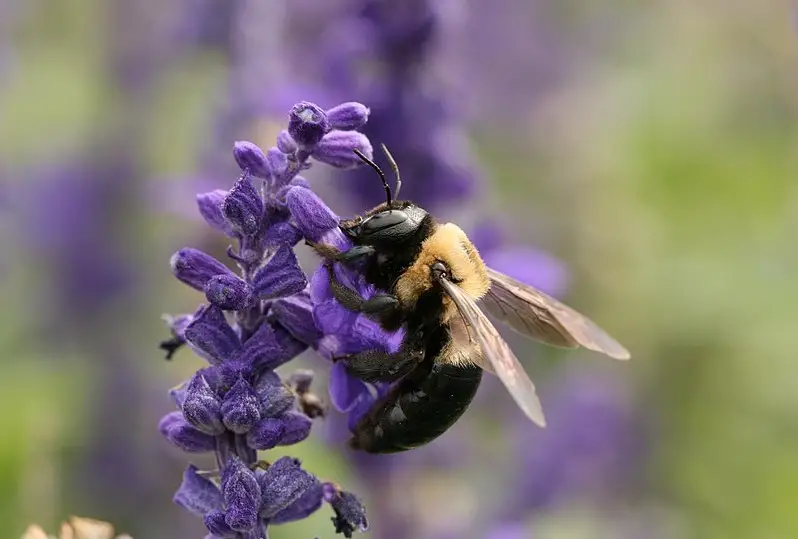
Xylocopa virginica, often known as the Eastern Carpenter Bee, gets its name from its habit of building its nests in wood. Under the direction of a queen, the colony divides up tasks like mating and maintaining the nest. They bring in honey and pollen sometimes, mostly to feed the newly emerged young bees, unlike honeybees who store both in the nest.
Brown-Belted Bumble Bee
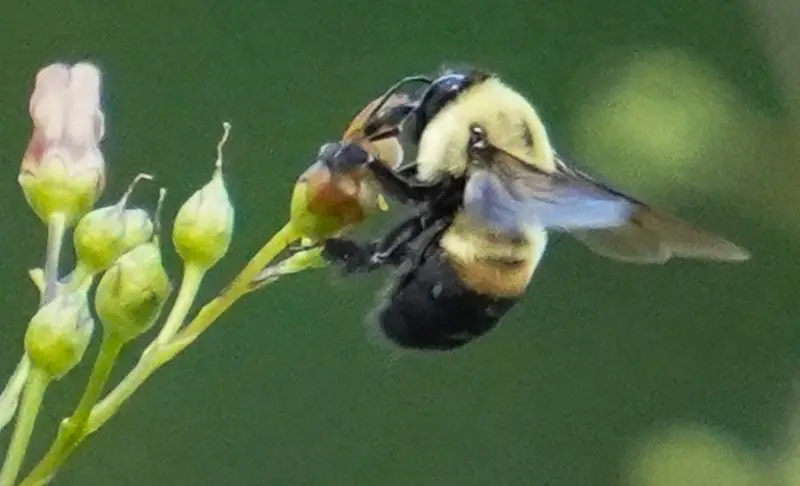
With the exception of a few Southeastern states, the Brown-belted Bumble Bee (Bombus griseocollis) is widely distributed throughout North America. They are ground-nesting and have a hierarchical organization, with workers in charge of maintaining the nests by rebuilding or repairing them with wax. To maintain the population of the colony, male bees concentrate on mating with the queen.
Sonoran Bumble Bee
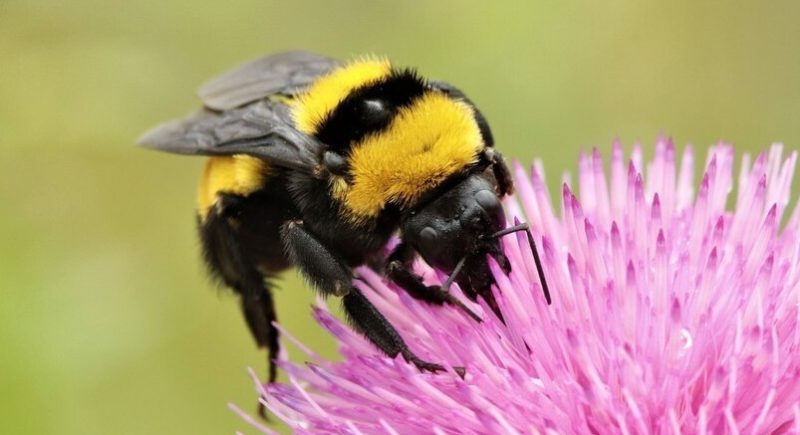
Its alternating black and yellow spots help identify the Sonoran Bumble Bee (Bombus sonorus), which is common throughout the southwestern US. It visits sunflowers and lavender plants frequently in search of pollen and nectar, and it is almost always active. North America’s arid valleys are a haven for colonies, which can endure up to a year.
Perplexing Bumble Bee
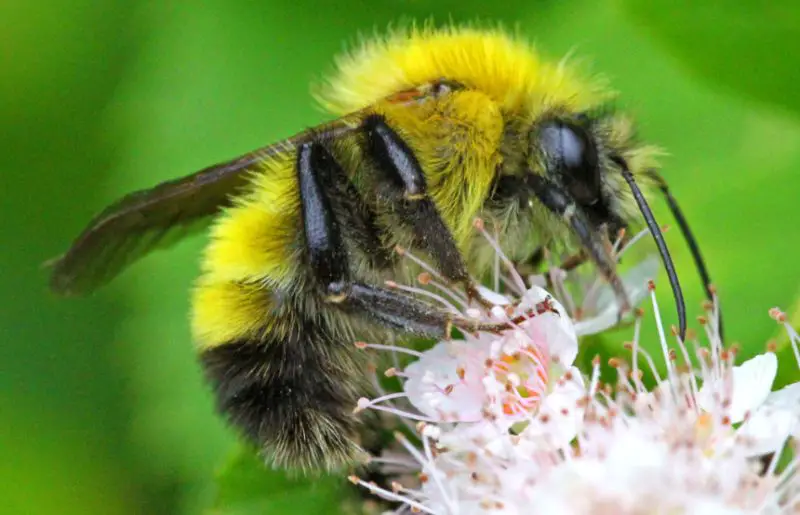
Native to North America, the Perplexing Bumble Bee (Bombus perplexus) is mainly found in Eastern US and Canada. Workers are distinguished from queens by their broader, brilliantly colored portion and their yellow and black hair. They live in marshes as well as dry environments and forests, in contrast to species that are similar.
Brown-Winged Striped Sweat Bee
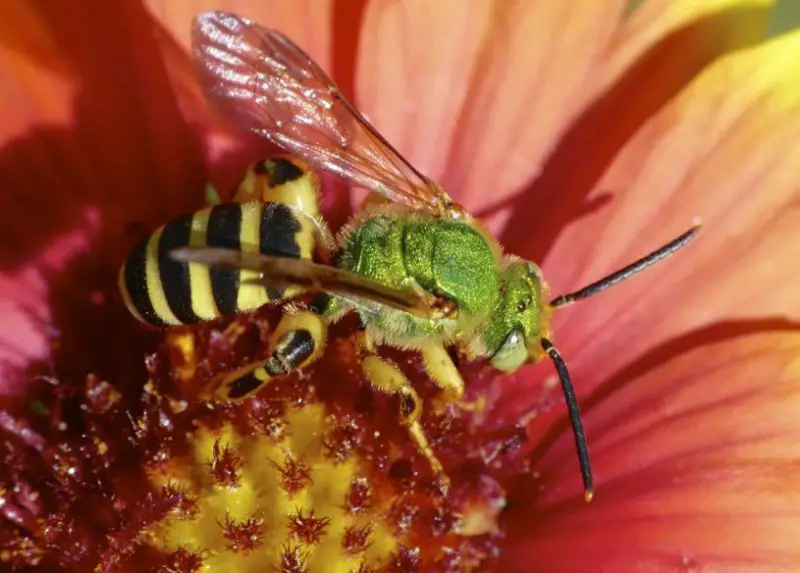
Agapostemon splendens, or brown-winged striped sweat bees, are found throughout the United States, most notably in Florida, and their season lasts until November. They are about 10mm in size on average, slightly smaller than some of its contemporaries the sweat bee. Compared to females, males are somewhat bigger. They can be distinguished by their striking bands of yellow-gold color and their metallic green base color.
Carpenter-Mimic Leafcutter Bee
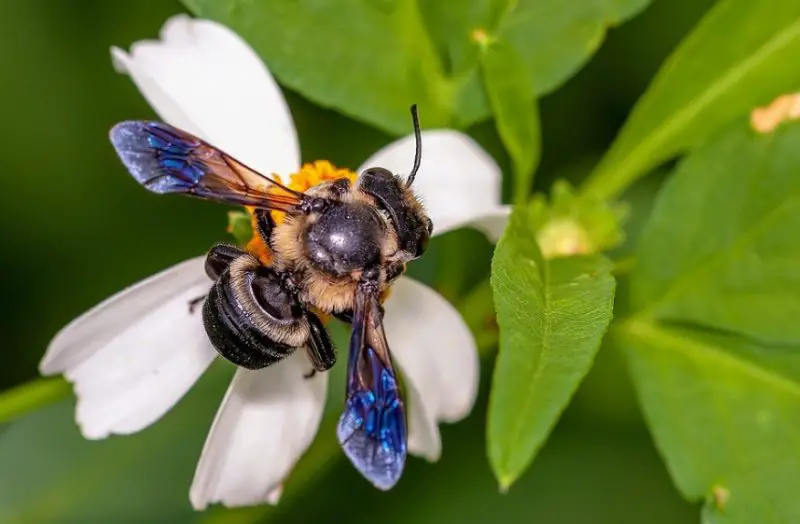
Because of its black coloring, the Carpenter-Mimic Leafcutter Bee (Megachile xylocopoides) resembles a carpenter bee. Its season lasts until November in Florida and September in other parts of North America. It gathers pollen on its abdomen, unlike other bee species, and uses it to supply food for the young bees in each of its separate nests. Typically, solitary females build a little nest to store pollen and lay eggs.
Half-Black Bumble Bee
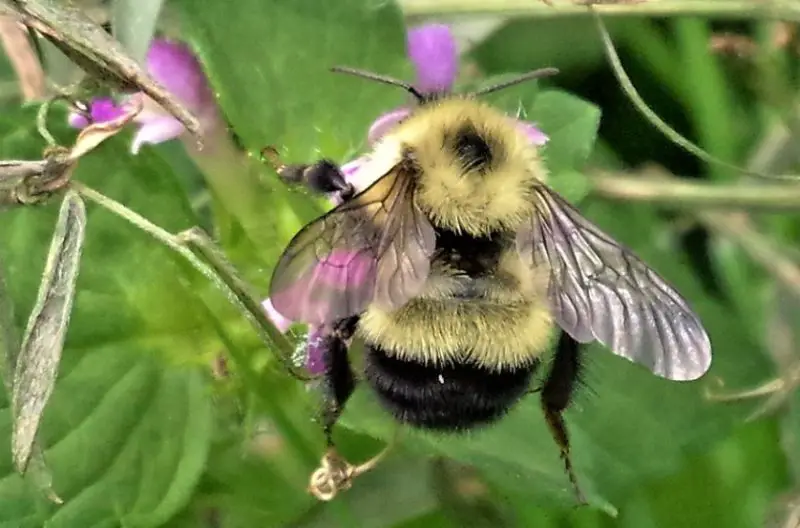
The Half-Black Bumble Bee (Bombus vagans) is a common woodland insect, frequently seen among goldenrod and asters. They are mostly found in Eastern North America, where they burrow their nests beneath the earth. They are solitary creatures that fit into their natural surroundings with a mixture of black and yellow facial and body hair.
Red-Belted Bumble Bee
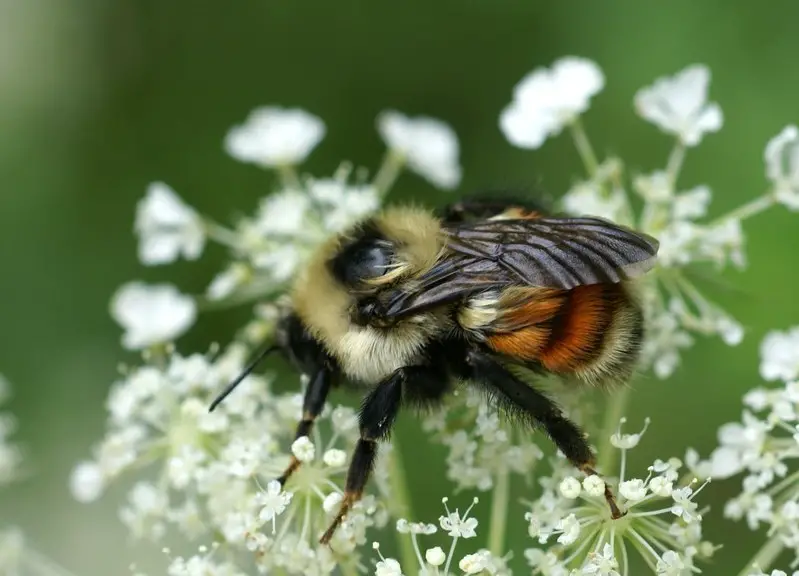
Native to North America, the Red-Belted Bumble Bee (Bombus rufocinctus) has an abdomen banded in red, black, and yellow and a thorax that is black and yellow. They nest in trees or cavities rather than underground, and they are common in urban areas of the Northwestern US. Early summer blossoms such as clovers, vetches, and strawberries entice them.
Metallic Epauletted-Sweat Bee
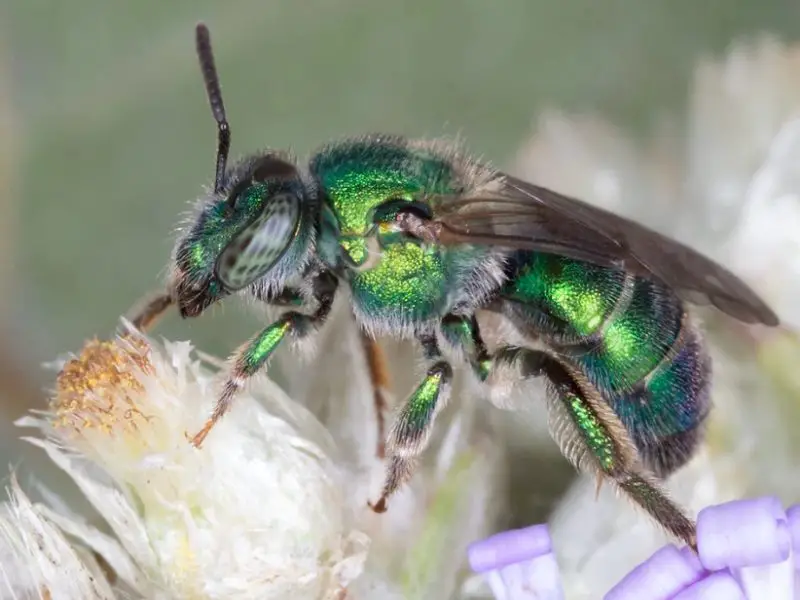
Common in the Eastern and Northeastern US states, the Metallic Epauletted-Sweat Bee (Augochloropsis metallica) is distinguished by its metallic green coloring on the head, thorax, and abdomen. It has smokey tan wings and a maximum size of 9 mm. It makes its nests above ground and is attracted to goldenrod and marigolds, among other flowers.
Sculptured Resin Bee
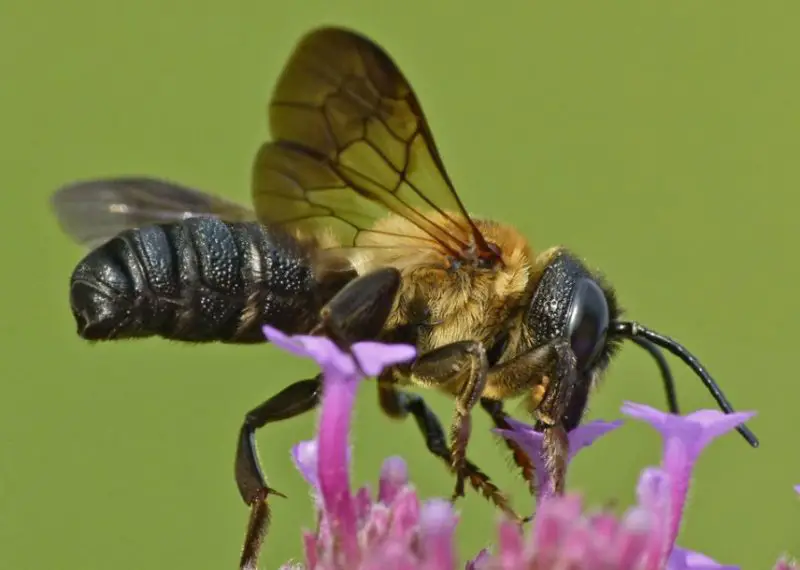
Introduced from Asia to North America, the Sculptured Resin Bee (Megachile sculpturalis) is colored in black and yellow. They reuse previous wooden nests as places to build, and they are frequently found in areas where carpenter bees also live. They use wood as nesting material even if they don’t pierce it themselves. They line their nests with mud, small wood fibers, and glue before laying eggs. Growing up to 25mm in length, they are larger than many native bees despite being imported.
Lemon Cuckoo-Bumble Bee

Native to the Eastern and Northeastern United States as well as Eastern Canada, the Lemon Cuckoo-Bumble Bee (Bombus citrinus) is a common invasive species that frequently preys on Common Eastern Bumble Bee nests by murdering the host queen. They do this by entering the nest by imitating the chemical cues of the host queen. They frequently get their pollen from asters.
Poey’s Furrow Bee
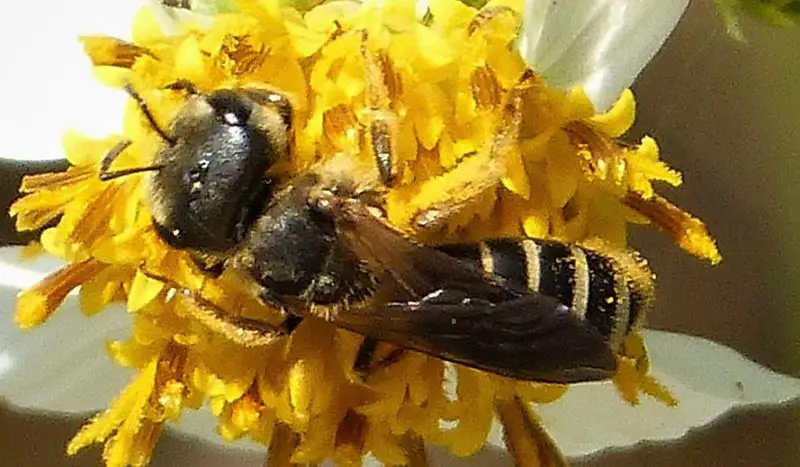
Unlike most North American bees, the Poey’s Furrow Bee (Halictus poeyi), which is native to Eastern North America, has a long flying season that lasts from February to November. It can be recognized by its smoky brown wings and black and yellow colors. It consumes different kinds of pollen. Males resemble females in physical size and have brilliant antennas.
California Bumble Bee
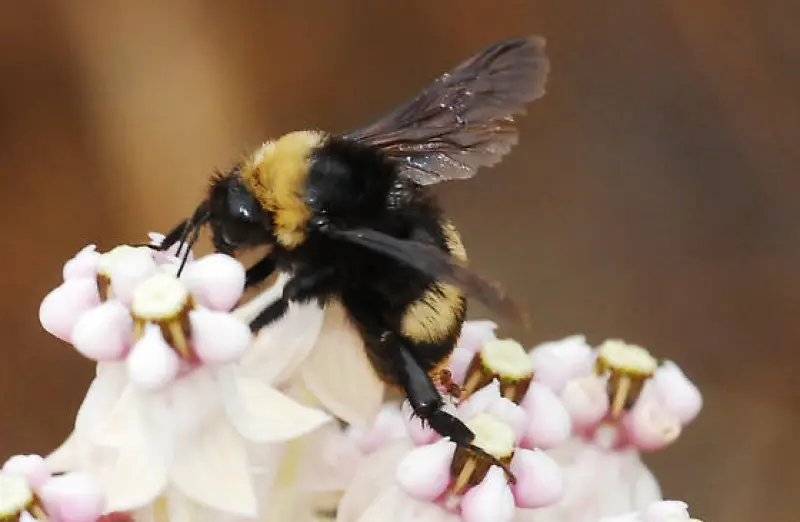
The hair bands of the California Bumble Bee (Bombus californicus) alternate between black and yellow, while its wings are smoky brown. It is becoming less common outside of California but is still very important for pollinating flowers, fruits, and crops, including sage, blueberries, and clover. It builds nests from spring through July and is active from spring until early September.
Rusty-Patched Bumble Bee
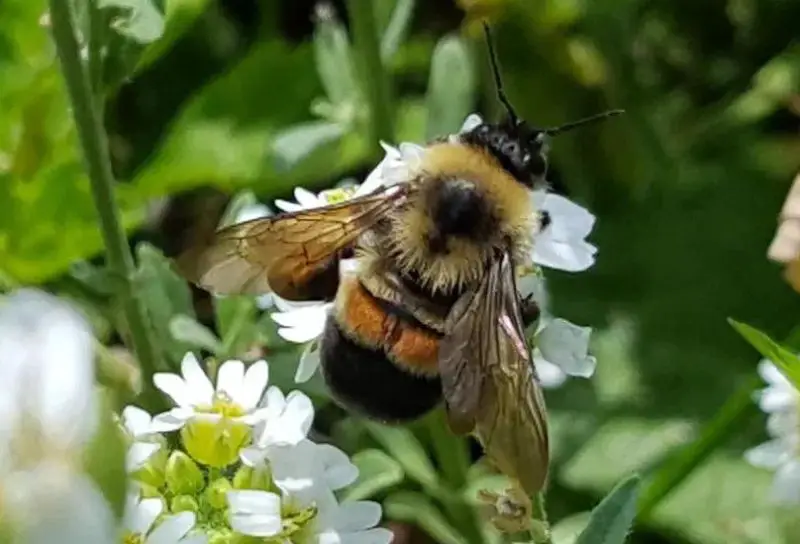
Only found in Northeastern North America, the Rusty-Patched Bumble Bee (Bombus affinis) is an important pollinator whose habitat is in danger of being lost. It overwinters at high altitudes or on dunes, nesting in both wet and dry soils. It is well known for pollinating many crops, such as onions, and is also necessary for fruits like apples and cranberries.
Wilke’s Mining Bee
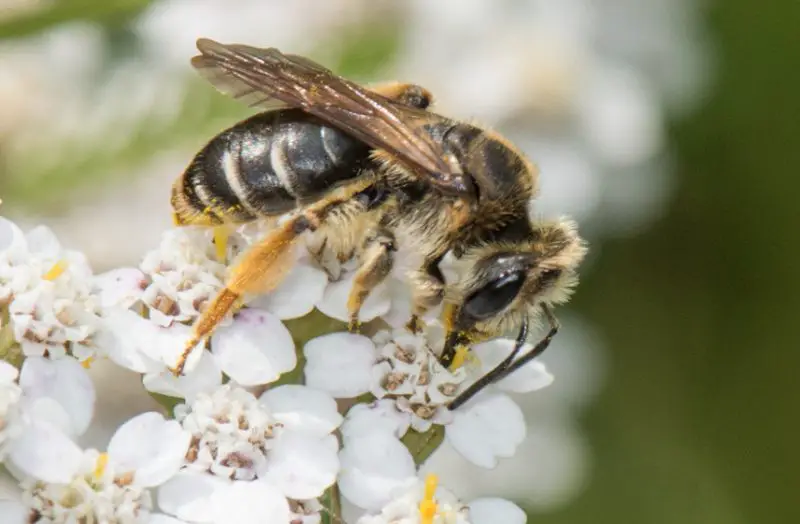
Native to Europe, Wilke’s Mining Bees (Andrena wilkella) were brought to North America. A female’s maximum growth is 12mm. They reside in communal nests or live solitary lives, feeding on legumes such as clover.
Blue Orchard Bee
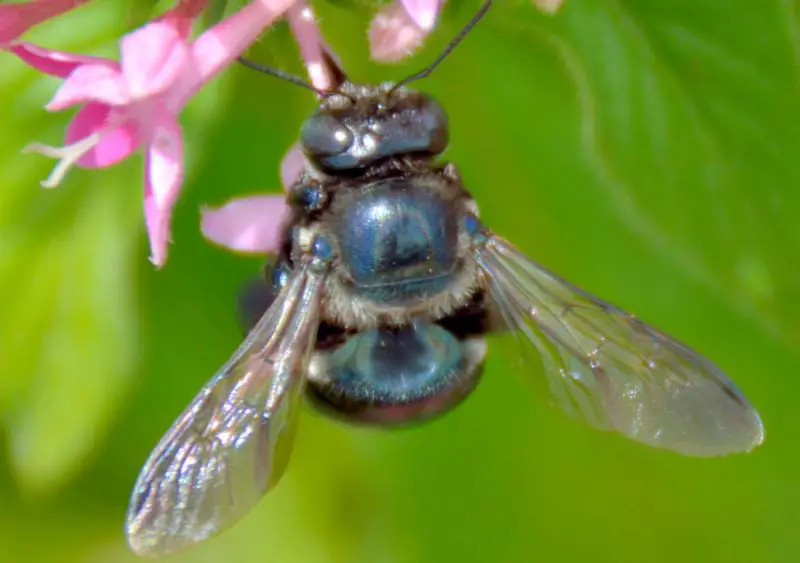
It’s usual to see blue orchard bees, or Osmia lignaria, near fruit trees. They can reach a maximum size of 15mm and are colored black or gray-black. In gardens, these productive pollinators are often observed, particularly in the vicinity of apple and cherry trees.
Horn-Faced Mason Bee
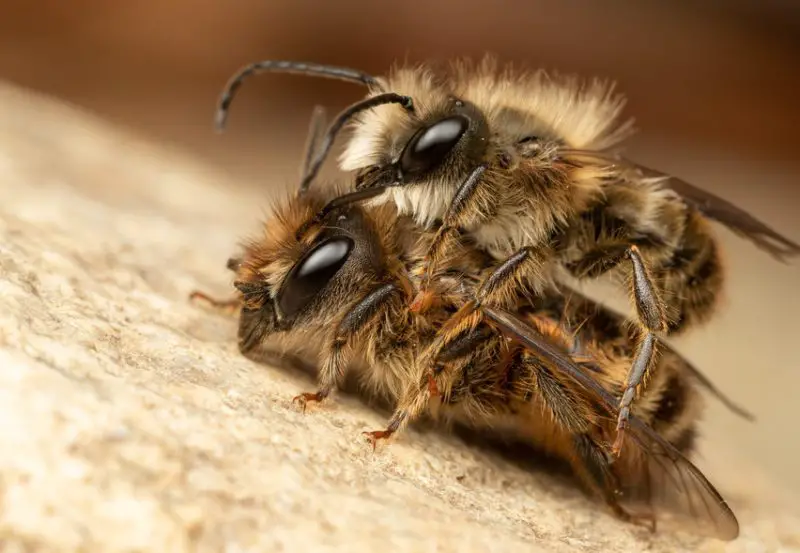
Originating in Eastern Asia, Horn-Faced Mason Bees (Osmia cornifrons) are common in Japan. Pollination of apple trees depends on them, as they visit several blooms every day. These bees use existing cavities, such as holes in logs or bamboo, to build their nests, either alone or in small groups, where the females lay their eggs.
Southern Plains Bumble Bee
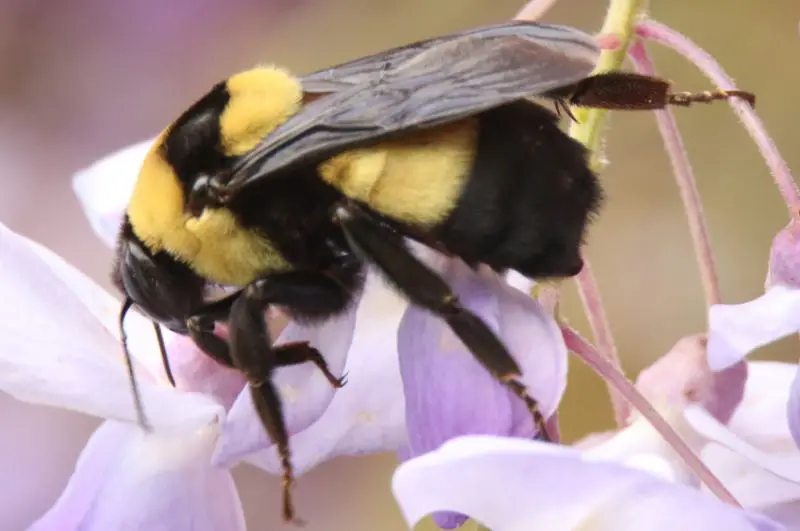
The Southern Plains Texas is a common place to find bumble bees, or Bombus fraternus. They take advantage of existing holes and suitable cavities to build their opportunistic nests. In the Southern plains, these bees flourish, pollinating bush clovers and milkweeds.
Blueberry Digger Bee
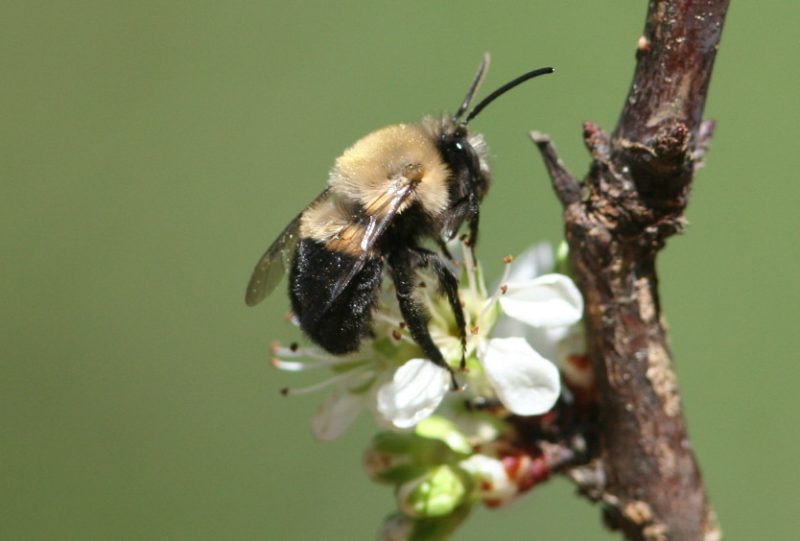
The Habropoda laboriosa, or blueberry digger bee, prefers dry, sometimes sandy soils for its breeding grounds. Regardless of gender, this Southern species is an expert blueberry pollinator. Though smaller than bumblebees, it is very effective throughout the day.
Oblong Woolcarder Bee
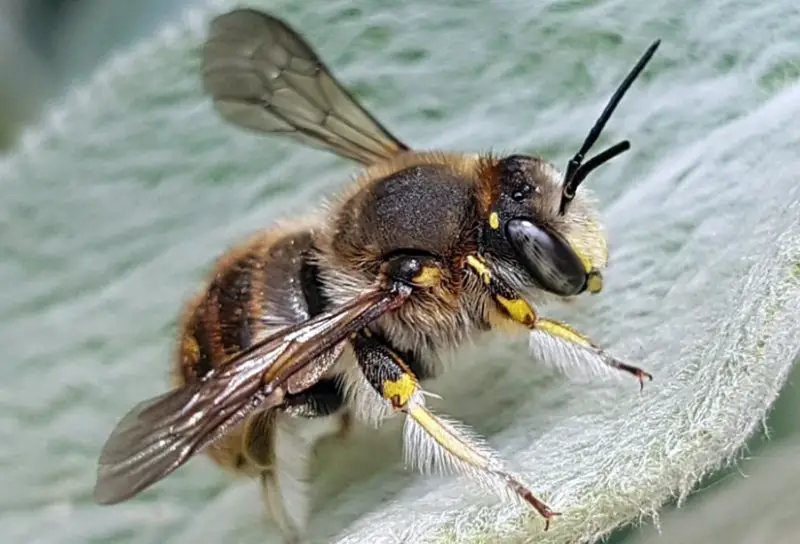
Originating in Europe and Asia, the yellow-and-black Oblong Woolcarder Bee (Anthidium oblongatum) is currently found in the eastern states of the United States. It uses cracks and crevices to build its nests in a variety of locations, including populated regions. It loves plants in the pea family, such as stonecrop, and is frequently found in gardens that include pea legumes.
Oblique Longhorn
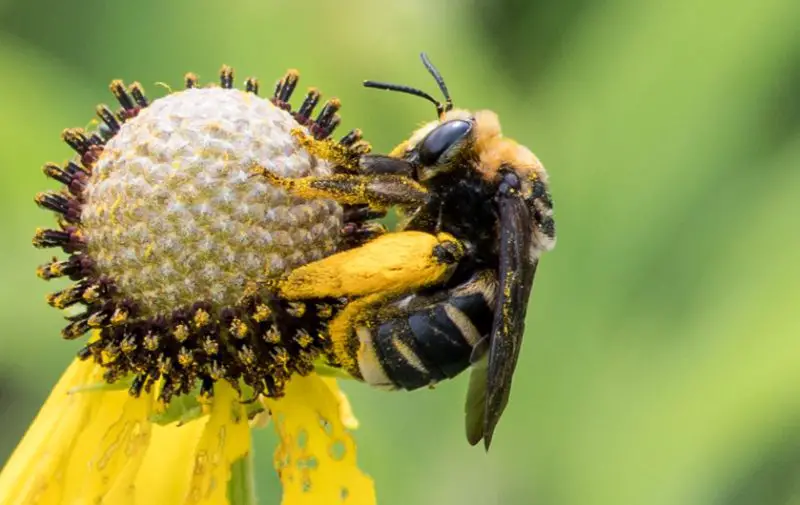
Solitary in nature, the Oblique Longhorn (Svastra obliqua) bee species is indigenous to Southern North America and Central America. Although they are usually solitary, they do sometimes share huge nests. Males and females differ slightly from one another, with males often having longer antennae.
Golden Sweat Bee
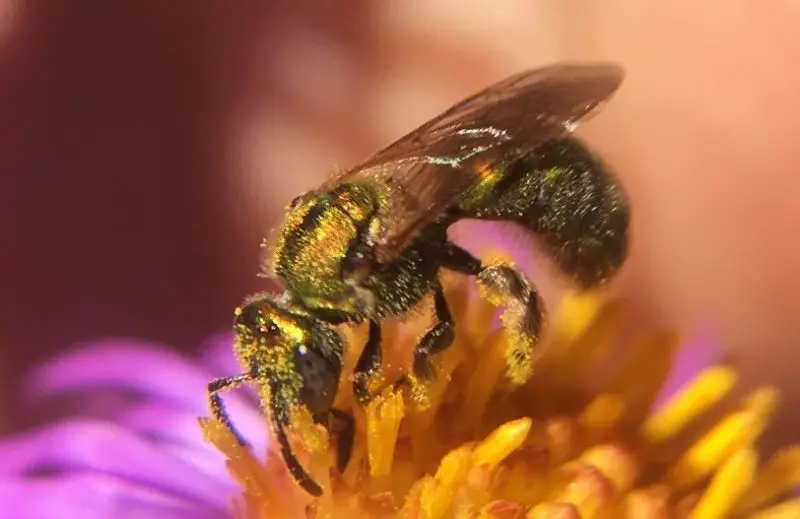
Males and females of the Augochlorella aurata, or golden sweat bee, are identified by their metallic green appearance. It lives in eastern Canada and eastern US, growing to a maximum size of 7 mm. Early in the summer, the eggs laid by the queen—who is well-known for social in-ground nesting—hatch into female assistants. Early fall or late summer is when male bees are produced by later broods. Some females may choose to nest alone on rare occasions.
Yellow-Fronted Bumble Bee
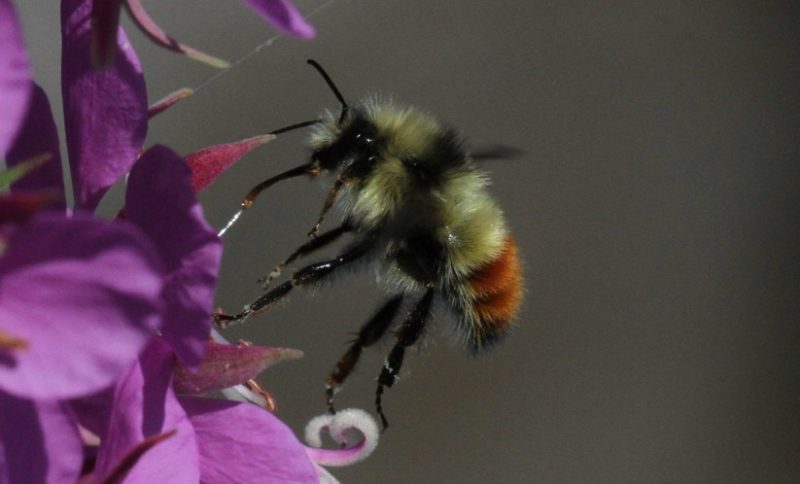
Growing up to 12 mm for workers and 19 mm for queens, the Yellow-Fronted Bumble Bee (Bombus flavifrons) is a big species found in high-elevation plains in North America. Only the queens and newly established queens overwinter in the nests that they build in March. They visit asters and mint, among other high-elevation blooms, and are vulnerable to cuckoo bee parasitism.
Modest Masked Bee
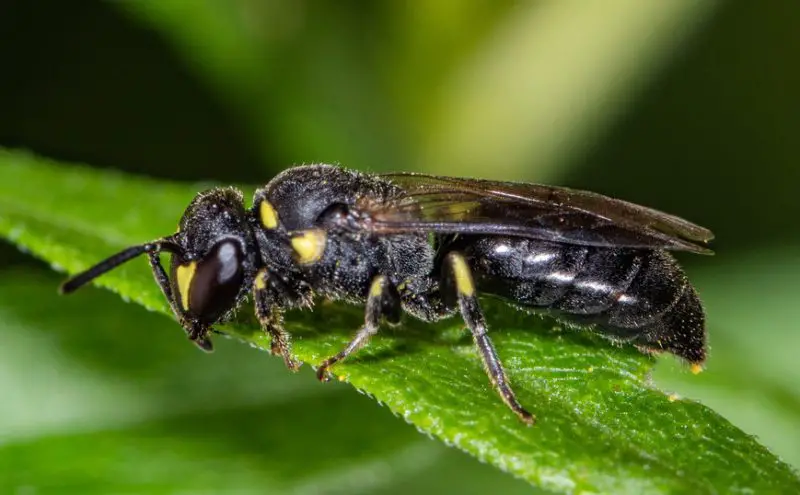
The Black Body and Legs of the Modest Masked Bee (Hylaeus modestus), so named because of the noticeable yellow mark on their faces. They are native to North America and can be found in large numbers on the West, East, and Northern territories. They eat common plants like goldenrod and milkweed.
Nevada Bumble Bee
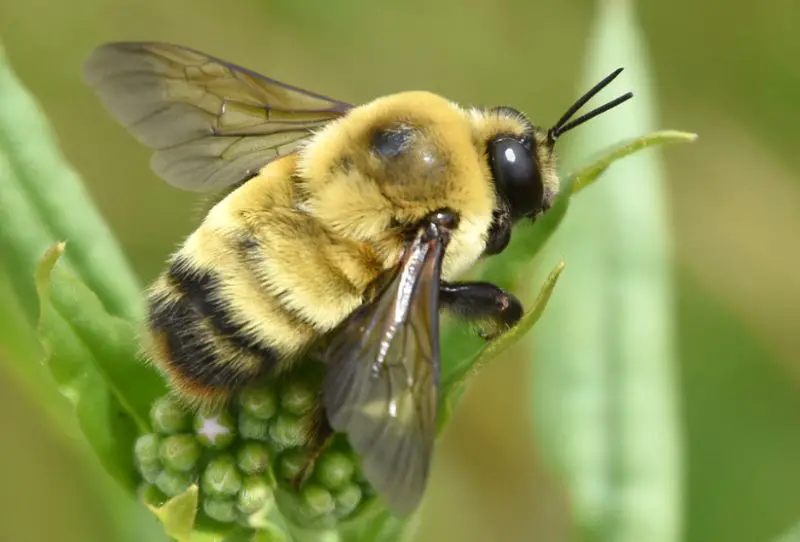
The Nevada Bumble Bee (Bombus nevadensis) is one of the largest native bees in North America, growing up to 15-20 mm in length, with workers up to 17 mm. With stripes of black and yellow, they are common in plains where they eat sage, thistle, salvia, and clover.
Urbane Digger Bee
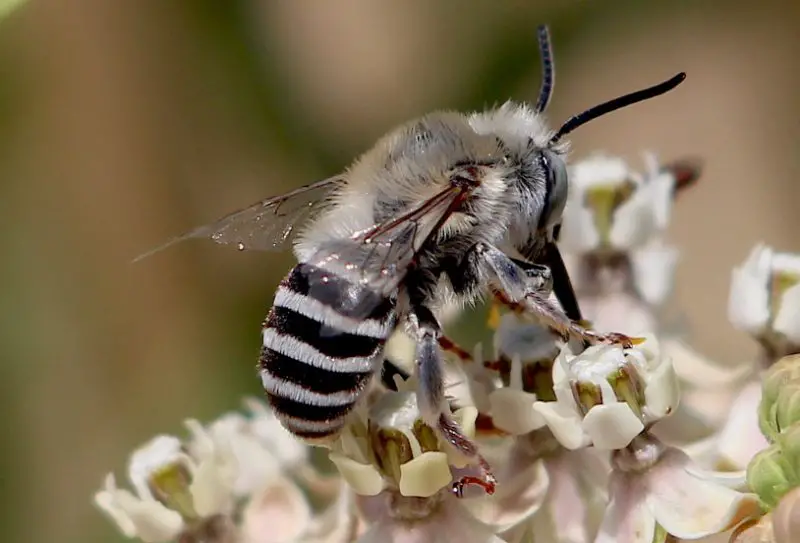
Anthophora urbana, often known as the Urbane Digger Bee, has a yellow, hairy thorax and a black and white abdomen. They nest on the ground close to plants they like, and are common in urban settings and gardens. In search of females, males patrol surrounding nests.
Pruinose Squash Bee
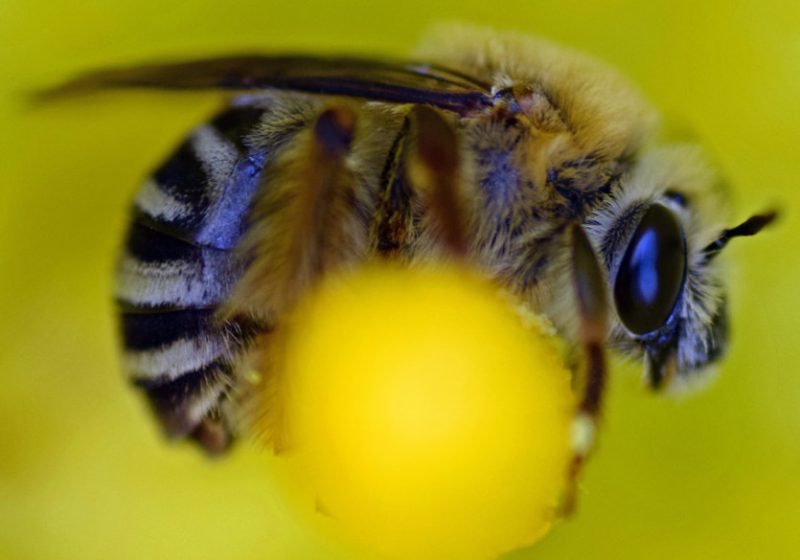
Fields are frequently visited by the Pruinose Squash Bee (Peponapis pruinosa), which is specialized in pollinating squash and pumpkin crops. Nesting on or close to crops, they only eat certain varieties of squash and are as effective at pollination as honeybees.
Northern Amber Bumble Bee
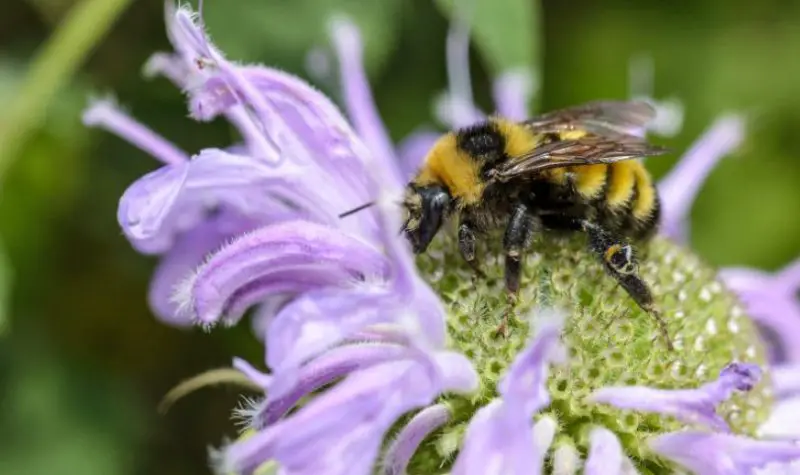
The Northern Amber Bumble Bee (Bombus borealis) is a woodland-dwelling species in North America that has black and dark yellow hairs all over its body. Known for its vital role in pollination, it frequents a variety of plants, including common vetches and blackberries.
Hibiscus Turret Bee
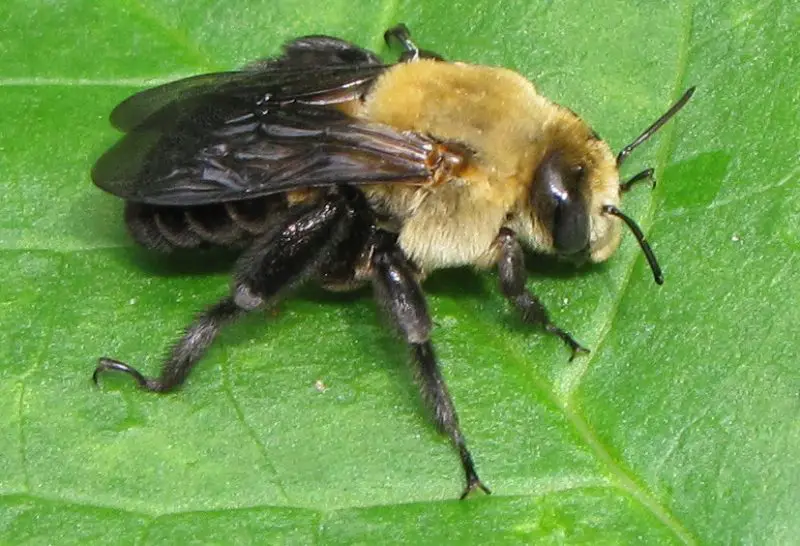
Ptilothrix bombiformis, or hibiscus turret bees, are drawn to hibiscus blooms and build their nests in soft soil close by. They are easily recognized by their hairless black abdomen and yellow, hairy thorax, and they are essential to pollination.
Yellow-Banded Bumble Bee
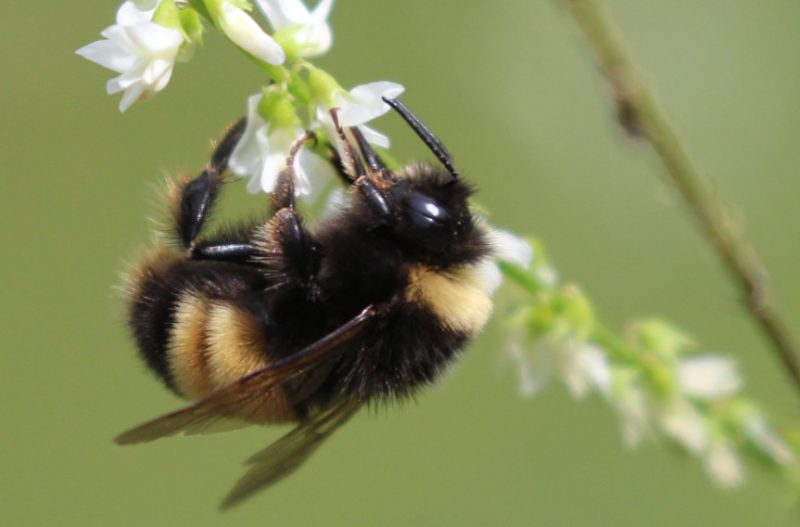
In spring, colonies of Yellow-Banded Bumble Bees (Bombus terricola) are established underground under the direction of a queen. In addition to pollinating crops, they also help maintain ecosystem biodiversity by pollinating a variety of non-crop plants. recognized by the yellow bands on their body.
Unequal Cellophane Bee
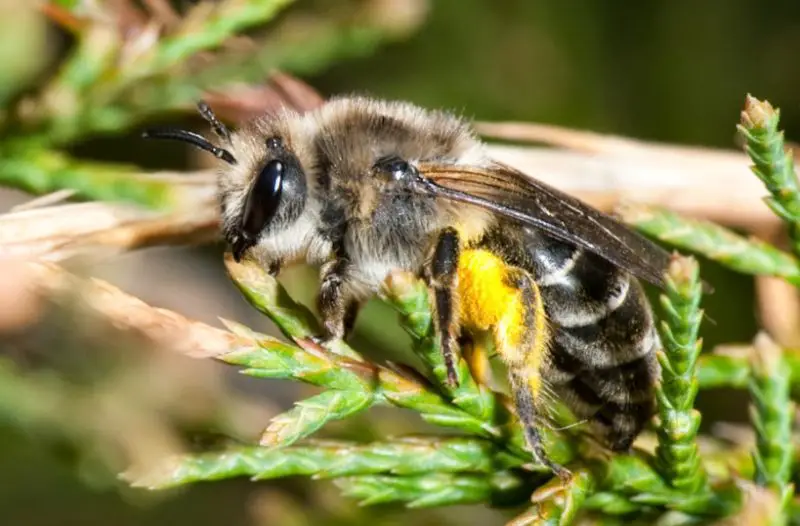
The Unequal Cellophane Bee (Colletes inaequalis) is a native of North America, found in riparian zones and forests, where it feeds on a wide range of park plants and trees. It typically builds its nests close to the plants that serve as its pollination hosts, favoring in-ground nests that face south for all-day sun exposure.
Flat-Tailed Leaf-Cutter Bee
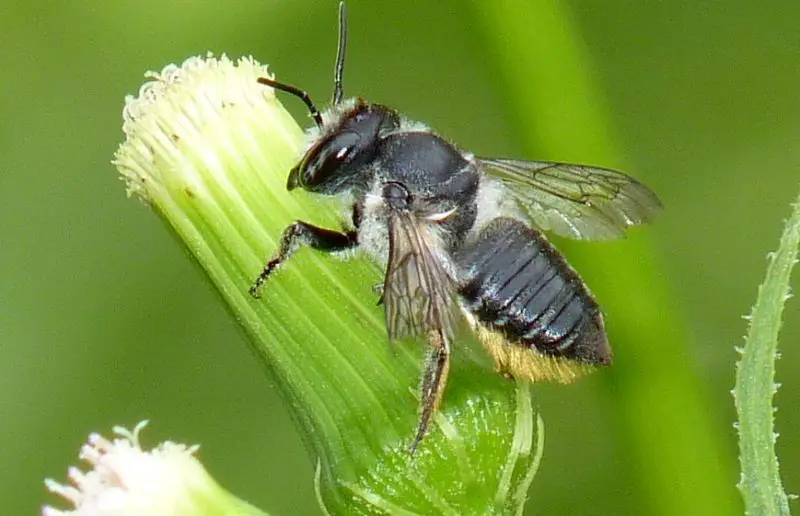
Originally from Eastern North America, the Flat-Tailed Leaf-Cutter Bee (Megachile mendica) has been observed sometimes on the West Coast. Plants such as the common buttonbush benefit from its pollination. It has a banded abdomen and a predominantly black body. It is active all year long in Southern states, with a different flying season depending on the region.
Orange-Legged Furrow Bee
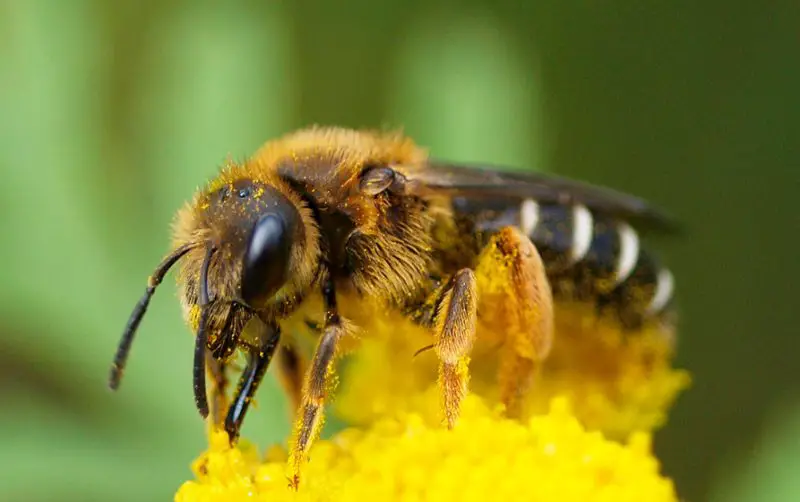
Halictus rubicundus, also known as the Orange-Legged Furrow Bee, is identified by its black abdomen, yellow-orange and black thorax, and orange legs. Both solitary and in colonies, they like to build their nests in the loose soil close to plants and rocks, especially at higher elevations. They are widespread across the world’s temperate zones and frequently excavate new nests next to old ones.
Western Carpenter Bee
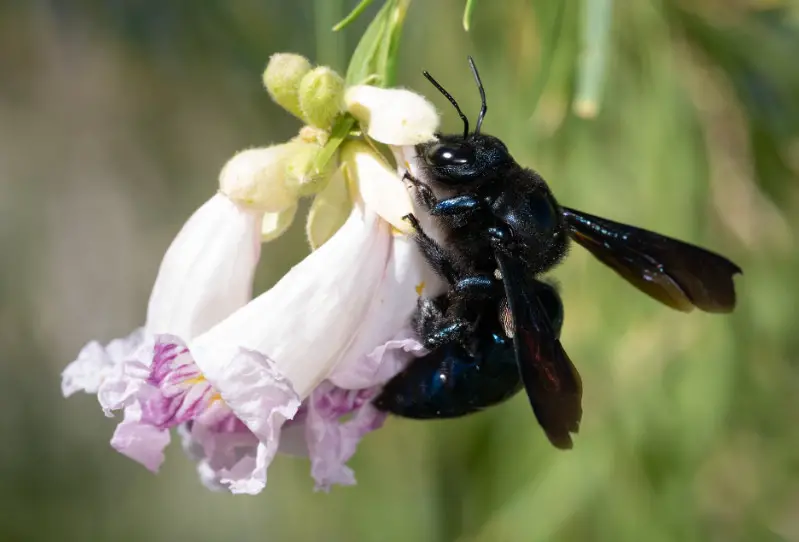
Found throughout California and Western North America, the Western Carpenter Bee (Xylocopa californica) can be found from Utah to Washington in the North and Texas and Arizona in the South. It is frequently seen on blooms in the cooler hours of hot summer days, and it prefers to collect pollen before midday, especially in environments in the South. Males and females can be distinguished by subtle changes in size and pigment; females usually have larger heads and more black hair.
Fuzzy-Horned Bumble Bee
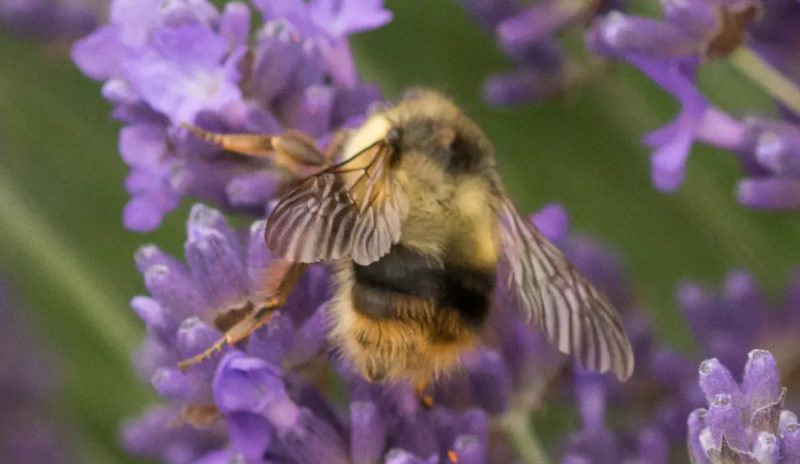
Native to the US and Canada, the fuzzy-horned bumble bee (Bombus mixtus) is distinguished by its hairless black legs and fuzzy black and golden-yellow coloring. It frequents slopes and open fields on mountains, where it prefers high-altitude environments. It feeds on flowers that grow at high altitudes, such as rhododendron and fireweed.
Texas Striped Sweat Bee
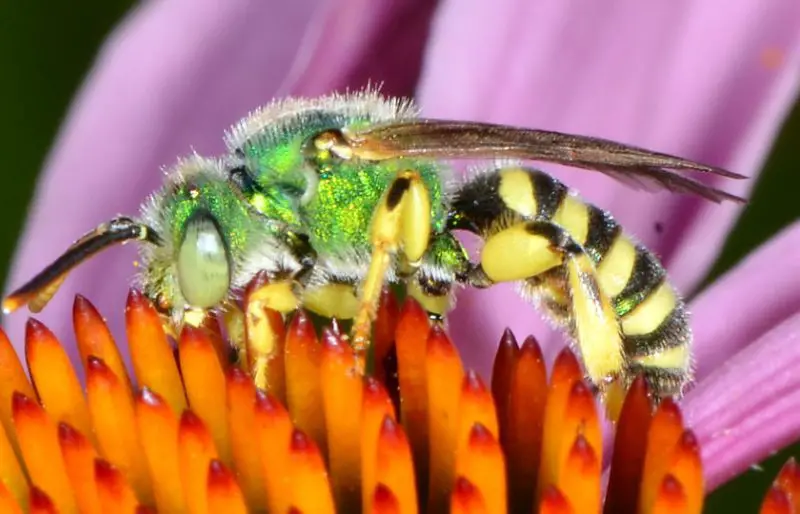
Known for its shiny green thorax, the Texas Striped Sweat Bee (Agapostemon texanus) is a species native to the South that is active from May to October. Its habitat spans from Canada to Central America, however in the North, its season ends in September. They soon build their own nests, choosing above-ground areas to avoid being eaten by flies and spiders.
Confusing Furrow Bee
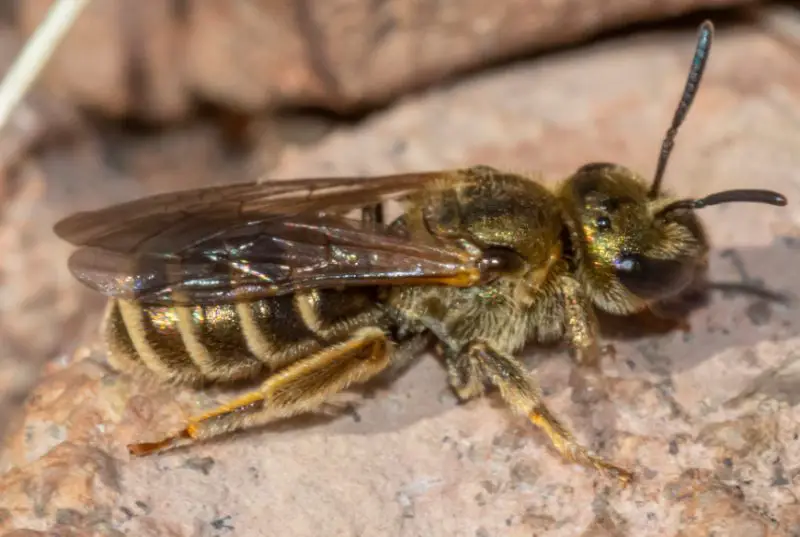
Throughout North America, the Confusing Furrow Bee (Halictus confusus) is a common species that builds its nests underground and has a simple social structure run by a queen and her workers. They feed on blooms like heath asters and favor sandy environments.
California Digger Bee
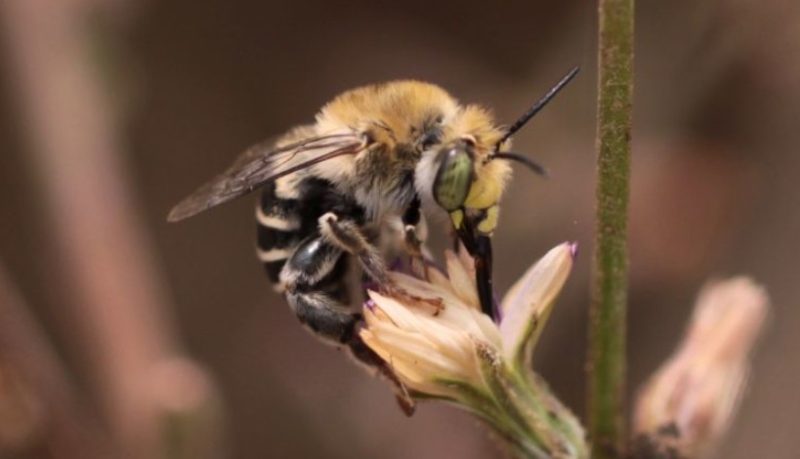
Nesting underground, the California Digger Bee (Anthophora californica) is a native of California. They can be recognized by their hairy yellow-orange thorax and hairless black-and-white banded abdomen. They frequently cluster their ground-level nests.
Alfalfa Leafcutter Bee
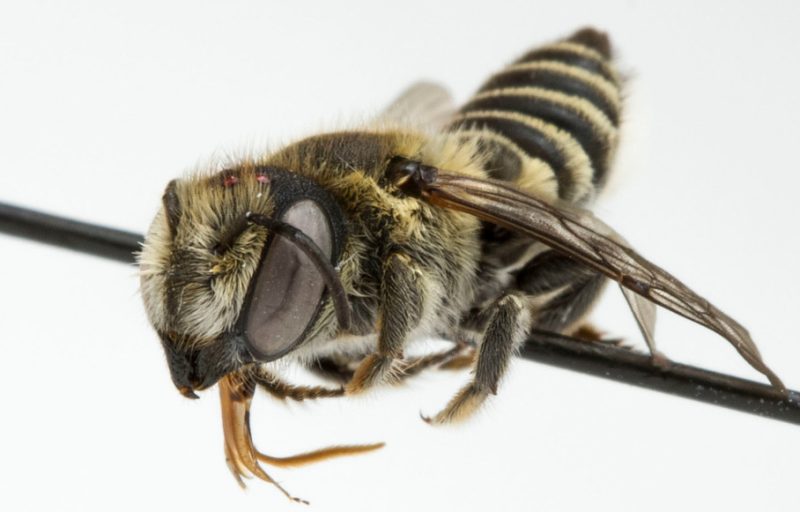
The Alfalfa Leafcutter Bee (Megachile rotundata), which was brought to North America in the middle of the 20th century to aid in the pollination of rapeseed and alfalfa crops, has since grown to be an essential component of agricultural operations. It nests in pre-existing holes in wood or dirt, unlike many other bee species, and lines its nests with leaves. These hardworking bees are essential pollinators, greatly enhancing the quality and output of rapeseed and alfalfa crops throughout the continent.
Peridot Sweat Bee
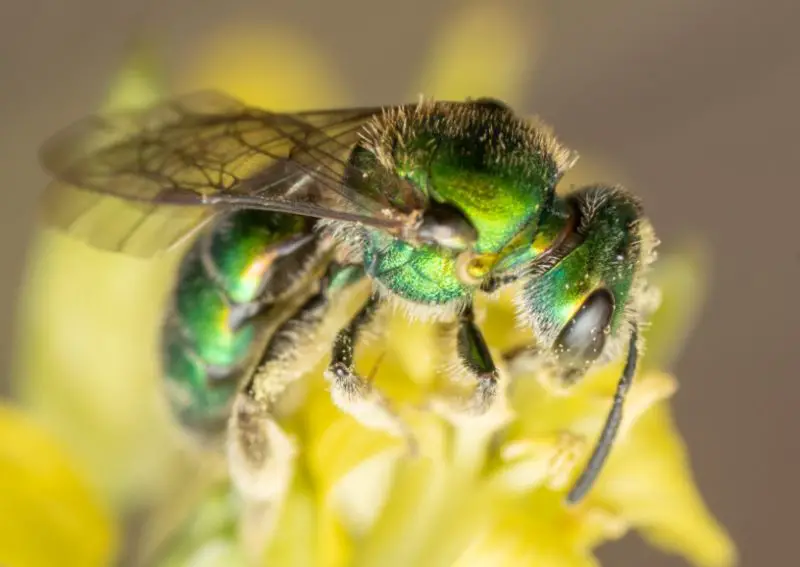
Augochlorella pomoniella, often known as peridot sweat bees, are distinguished by their metallic green color with undertones of golden yellow and smoky wings. They land on humans much like regular sweat bees do. They have a long season and only hibernate in January.
Western Leafcutter
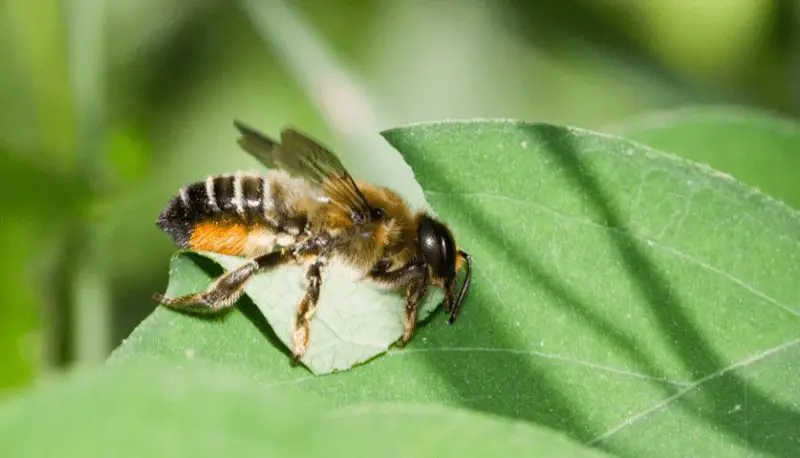
The colors white, yellow, black, and brown are characteristics of the Western Leafcutter bee (Megachile perihirta). Located to the west of the Rocky Mountains, it builds nutrient-rich nests for its young by using leaves found in cracks and holes in the ground.



